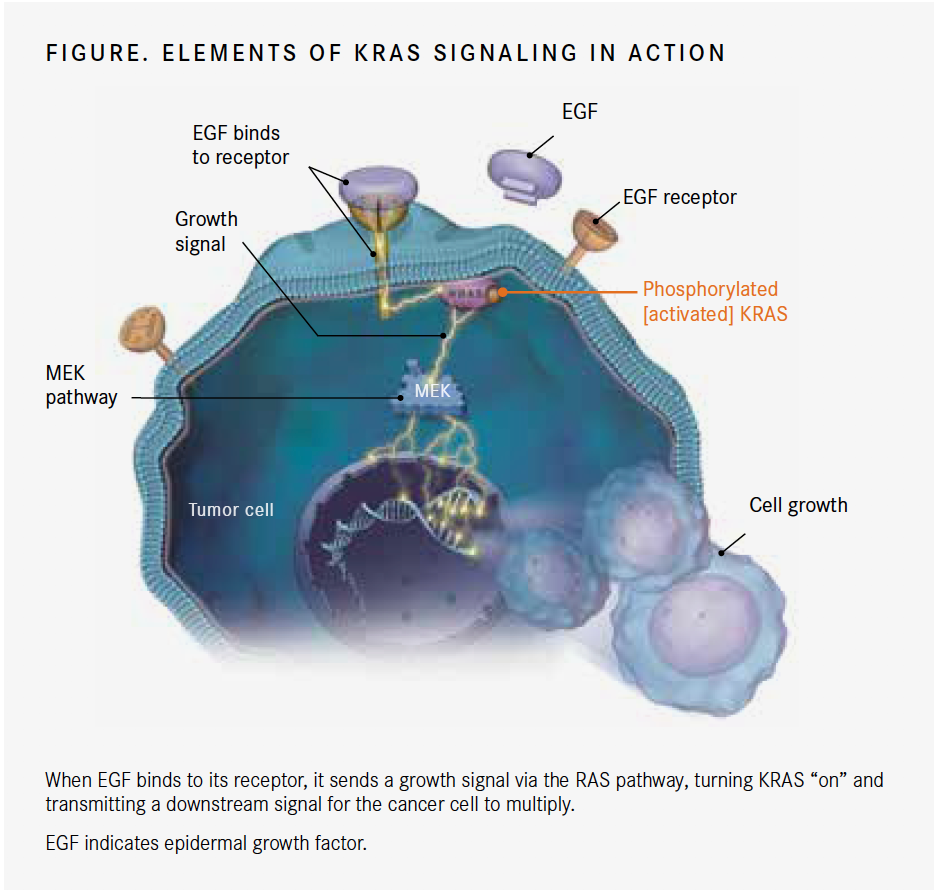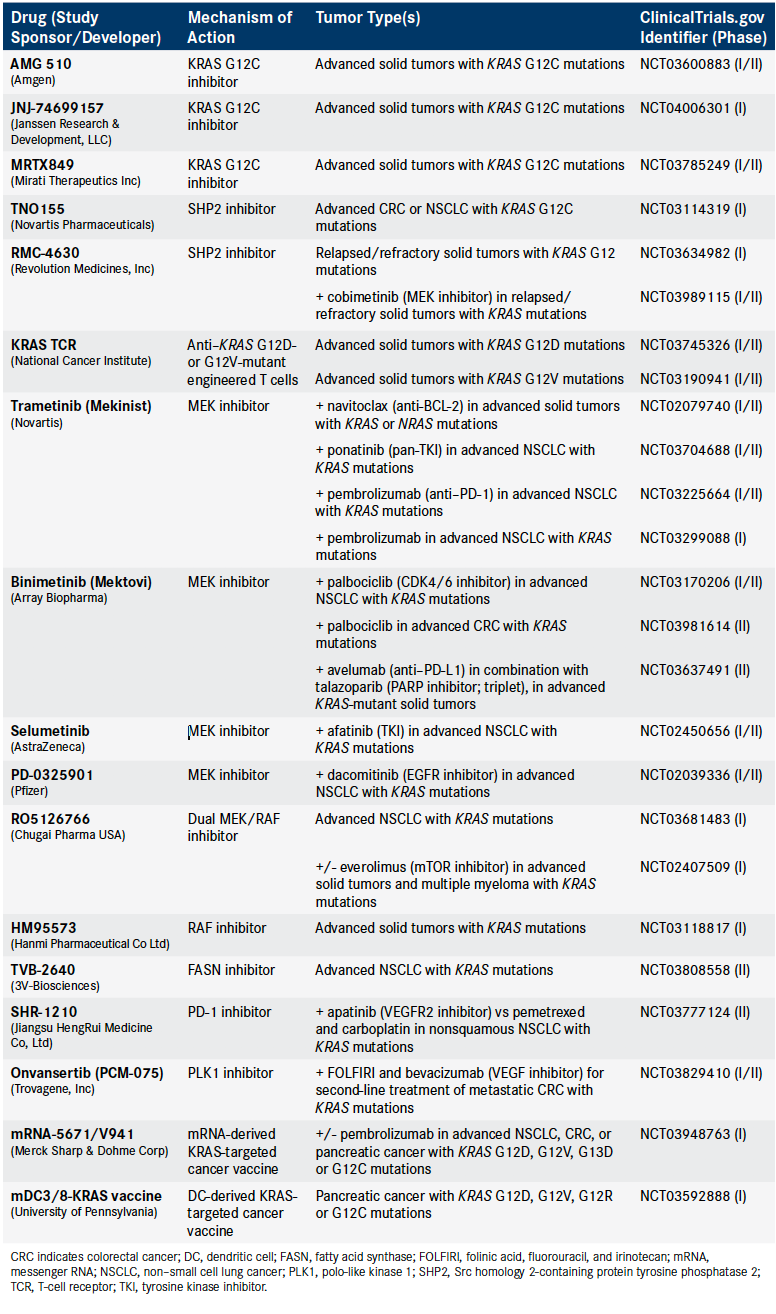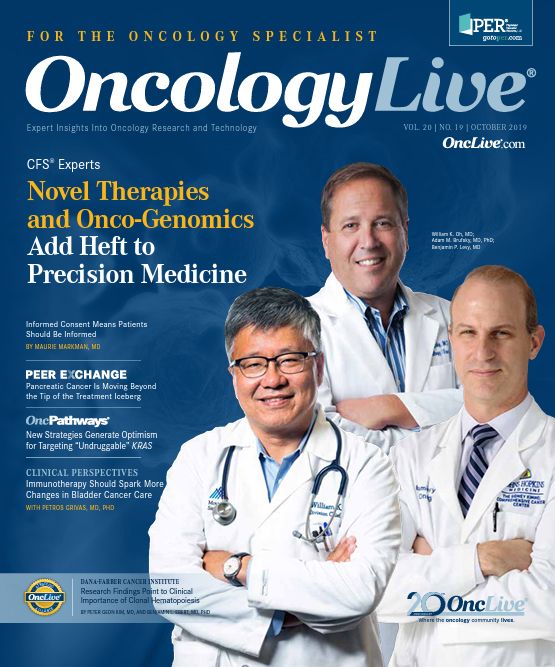New Strategies Generate Optimism for Targeting "Undruggable" KRAS
Investigators are starting to make headway in their quest to develop therapies that counteract oncogenic mutations in the KRAS gene, a high-priority target in precision medicine that has long been deemed “undruggable.”
Vassiliki Papadimitrakopoulou, MD, chief, Section of Thoracic Medical Oncology, the University of Texas MD Anderson Cancer Center

Vassiliki Papadimitrakopoulou, MD
After 30 years of frustration, investigators are starting to make headway in their quest to develop therapies that counteract oncogenic mutations in the KRAS gene, a high-priority target in precision medicine that has long been deemed “undruggable.”1-3
The discovery of binding pockets on a mutant form of the KRAS protein encoded by KRAS G12C has facilitated the development of novel mutant-specific inhibitors that are showing promise.4-6
In June, data demonstrating that AMG 510, a small-molecule inhibitor of KRAS G12C, elicited objective responses in patients with KRAS-mutant non—small cell lung cancer (NSCLC) generated much excitement at the American Society of Clinical Oncology Annual Meeting (ASCO 2019). Amgen, the company developing the drug, subsequently said the agent has also induced responses in colorectal (CRC) and appendiceal cancers.7,8
Click to Enlarge

Discussing KRAS was not a very exciting task a couple of years back, but this year, it is a very exciting task because we have made a lot of progress,” Vassiliki Papadimitrakopoulou, MD, the Jay and Lori Eisenberg Distinguished Professor of Medicine and section chief of thoracic medical oncology in the Department of Thoracic/Head and Neck Medical Oncology at The University of Texas MD Anderson Cancer Center in Houston, said at the 20th Annual International Lung Cancer Congress®.9
Papadimitrakopoulou, who is joining Pfizer’s clinical development team in late September, said the early AMG 510 results are “very significant and groundbreaking data, even with the small number of patients. We will need to deal with other subsets of KRAS mutations, and also we will need to think creatively as the data lead us and as we treat patients with the direct inhibitors.”
History has taught us that, where KRAS is concerned, there may be many twists and turns in this story yet to come. For now, there is fresh, albeit cautious, optimism.
Control Switch
The KRAS protein is a member of the RAS family of proteins, which includes 4 highly similar members: HRAS, NRAS, and 2 alternatively spliced KRAS isoforms, KRAS4A and 4B. These 4 proteins, in turn, are members of the much larger RAS superfamily of guanosine triphosphatases (GTPases) that essentially function as molecular switches, controlling vast intracellular signaling networks.
GTPases are hydrolase enzymes that bind the nucleotide guanosine triphosphate (GTP) and catalyze its conversion into guanosine diphosphate (GDP). The RAS proteins are made in the cytosol and then a tag is added that anchors them in the cell membrane. Once there, they are activated by growth factors and other signals that lead to the recruitment of guanine nucleotide exchange factors that release GDP and allow the RAS proteins to load up with GTP instead.
Each RAS protein contains several regions: an effector region, which contains 2 switch domains, and an allosteric region make up the G-domain, which is where GTP binding and GTPase activity take place. When GTP is loaded, the switch regions undergo a conformational change that facilitates the recruitment and activation of different effector proteins. Additionally, there is a hypervariable region (HVR) that contains a CAAX motif to which those tags that facilitate membrane localization can be added. As its name implies, the HVR is the most variable region of each RAS isoform.
In the GTP-bound form, RAS proteins, particularly KRAS, activate a host of downstream proteins that propagate the signal from the cell membrane to the nucleus and ultimately activate the expression of genes involved in key cellular processes, including growth and survival.
The most widely studied downstream effectors are the RAF family of serine/threonine kinases. Activated RAFs play a key role in the MAPK pathway; they phosphorylate and activate the MEK1 and MEK2 kinases, which in turn activate the MAPKs ERK1 and ERK2. Among their potential targets is the ETS family of transcription factors, which can repress or activate the transcription of many target genes.
Table. Select Ongoing Clinical Trials in KRAS-Mutant Cancers (Click to Enlarge)

High-Priority Target
Because of their central position at the axis of many important cell signaling networks, the RAS proteins are implicated in numerous cancer hallmarks. The RAS proteins are so named because they were first identified in studies of rat sarcomas caused by potently oncogenic viruses.1,2 Mutations that activate these proteins have now been identified in approximately one-fifth of all human tumors.3,10,13
The majority of mutations occur in codons 12, 13, and 61 in all RAS genes, and they mostly affect switch regions or other parts of the RAS proteins that would likely alter enzymatic activity.14 The most commonly mutated family member is KRAS (in about 85% of cases), followed by NRAS (about 15%); HRAS represents the fewest cases (<1%). However, the specific gene that is mutated, the relative mutational frequencies, and the specific type of mutation vary across tumor types.3,10,11
The KRAS gene is most prominent in pancreatic adenocarcinomas, observed in more than 80% of cases, but it is also found in 30% to 40% of CRCs and 15% to 20% of lung cancers (most commonly NSCLC), as well as biliary tract, endometrial, cervical, bladder, liver, and breast cancers.3,10,13
For many years, the RAS proteins, KRAS in particular, have been high-priority targets in cancer drug development, but they have proved steadfastly elusive. Except for the GTP-binding site, the protein’s structure does not provide any useful pockets where a small-molecule inhibitor might bind. The development of GTP-competitive inhibitors has not been feasible due to the extremely high affinity of the RAS proteins for GTP combined with high concentrations of GTP in cells.
For this reason, the focus of drug development turned to ways to indirectly target the RAS proteins. Many of the proteins within the broader RAS signaling network are kinases that are more amenable to targeting. Inhibitors of the upstream activator EGFR and the downstream effectors RAF, MEK, and ERK have been evaluated in patients with RAS-mutant tumors.
Although EGFR, BRAF, and MEK inhibitors have gained FDA approval in various indications, they show limited single-agent efficacy in patients with RAS mutations, in part because of mechanisms that lead to paradoxical reactivation of RAS or components of the RAS pathway.11,15 Nonetheless, investigators have persisted, focusing on combinations that could overcome these mechanisms of intrinsic resistance.
Membrane localization is essential to RAS function, and efforts to block membrane association led to the development of farnesyltransferase inhibitors (FTIs). These agents are designed to prevent the addition to RAS proteins of a farnesyl tag, which mediates their binding to membranes. FTIs initially appeared extremely promising but floundered in phase III trials, likely because the FTIs were circumvented by the existence of a second enzyme capable of adding an alternative tag.
Another avenue of research has been the search for synthetic lethal interactors with RAS mutations. These interactors are proteins that the RAS-mutant tumor cells (but not wild-type cells) depend on for viability; thus, blocking their expression or activity kills tumor cells and spares healthy cells.3,16
These study findings suggest the potential therapeutic relevance of CDK4 in KRASmutant tumors.17,18 CDK4/6 inhibitors have been successfully developed for the treatment of hormone receptor—positive breast cancer. In KRAS-mutant NSCLC, abemaciclib (Verzenio) appeared promising in a phase I trial, demonstrating a disease control rate of 55.2%.19 The subsequent phase III JUNIPER trial compared abemaciclib with the EGFR inhibitor erlotinib in patients with advanced KRAS-mutant NSCLC. Although there was no benefit in overall survival, abemaciclib significantly improved progression-free survival and objective response rates (ORRs) compared with erlotinib.20,17
Preclinical studies have demonstrated potential synergy between CDK4/6 inhibitors and other drugs, including MEK inhibitors, and clinical trials are ongoing.
Other promising synthetic lethal interactors include SHP2 (also known as protein tyrosine phosphatase non-receptor type 11) and polo-like kinase 1. Inhibitors of both are in the early stages of development in KRAS-mutant tumors.21-23 In a preclinical study, the effects of SHP2 inhibition were enhanced when MEK activity was blocked.22
Direct Inhibitors Offer New Hope
Repeated clinical disappointments took their toll on RAS-directed drug development, and many pharmaceutical companies abandoned their efforts to target the proteins. In 2013, momentum was regained with the launch of the National Cancer Institute’s RAS Initiative, designed to pump $10 million a year into a wide-ranging research and development collaboration between academia and the pharmaceutical and biotechnology industries.1
In that same year, the first report of a novel design of a KRAS inhibitor was released.6 One of the most common KRAS mutations is G12C, representing half of KRAS mutations found in patients with lung adenocarcinomas.3 The mutated cysteine residue can form a covalent bond with certain drug compounds that block the activity of the mutant protein.
A pocket was identified in the mutant protein where small-molecule inhibitors might be able to bind. Interestingly, the pocket was revealed only in the GDP-bound form and was previously ignored in drug development efforts because oncogenic mutations in KRAS were thought to cause the protein to become stuck in the GTP-bound form.
Instead, it turned out that this particular mutant form was still switching on and off—but at a much faster rate than the wild-type protein. These new inhibitors are designed to force the broken switch to stay in the off position.4-6,24,25
Wellspring Biosciences and its parent company, Araxes Pharma, pioneered preclinical development of RAS inhibitors using this approach,26 but Amgen reported the first clinical trial data for a similarly designed drug, AMG 510, at ASCO 2019.8
AMG 510
Preliminary results were reported from a phase I, open-label, multicenter study in which 35 patients were enrolled in the first 4 dosing cohorts (180, 360, 720, and 960 mg). At the time of the presentation, 29 patients were evaluable for response, 10 of whom had NSCLC. Most patients had been treated with ≥3 prior lines of therapy.
Half of the patients with NSCLC experienced partial responses (PRs), 4 of which were confirmed; all of these patients were still on treatment at the time of the report. The most common treatment-related adverse events (AEs) were decreased appetite, diarrhea, fatigue, headache, cough, hot flush, and nausea. Six patients had serious AEs, including grade 3 pneumonia and malignant biliary obstruction and grade 4 pericardial effusion, none of which were considered related to AMG 510.8
Efficacy was maintained in the NSCLC cohort, according to updated results presented at the 2019 World Conference on Lung Cancer in September. The findings covered 34 patients with NSCLC treated with AMG 510, including 19 who were treated in the dose-escalation phase with doses starting at 180 mg and 15 who were treated in the expansion phase at the determined phase II dose of 960 mg once daily.
No dose-limiting toxicities were observed among the patients with NSCLC, and although 4 patients discontinued treatment, none discontinued due to AEs. At the time of data cutoff, 27 patients remained on treatment. Among 23 evaluable patients who had completed the first 6-week CT scan or had early progressive disease, the ORR was 48% and the disease control rate was 96%. Thirteen of the evaluable patients received the phase II dose of 960 mg; of these patients, 7 (54%) achieved a PR and 6 (46%) achieved stable disease.27
Based on these data, the FDA granted a fast track designation to AMG 510 for patients with KRAS G12C—mutated metastatic NSCLC who have received prior treatment, according to Amgen.28 Moreover, the company recently reported that responses have been seen in patients with CRC and appendiceal tumors. The agent is also being tested in combination with PD-1 inhibition.7
Additional Novel Therapies
Other pharmaceutical companies are pursuing KRAS G12C-specific inhibitors. In July, Janssen Research and Development launched a phase I study to test JNJ-74699157 in patients with advanced solid tumors with the KRAS G12C mutation (NCT04006301). Janssen is developing the molecule, formerly ARS-3248, under an agreement with Wellspring and Araxes.26
Mirati Therapeutics is currently evaluating MRTX849, a small-molecule inhibitor of KRAS G12C, in a similar patient population in a phase I/II study (NCT03785249).
Overall, the RAS proteins have relatively low intrinsic GTPase activity, but the binding of GTPase-activating proteins enhances this activity. The signal is then terminated as GTP is hydrolyzed back to GDP. Thus, the RAS proteins switch between the GDP-bound form (“off”) and the GTP-bound form (“on”).3,10-12
References
- Thompson H. US National Cancer Institute's new Ras project targets an old foe. Nat Med. 2013;19(8):949. doi: 10.1038/nm0813-949.
- Malumbres M, Barbacid M. RAS oncogenes: the first 30 years [erratum in Nat Rev Cancer. 2003;3(9):708]. Nat Rev Cancer. 2003;3(6):459-465. doi: 10.1038/nrc1097.
- Liu P, Wang Y, Li X. Targeting the untargetable KRAS in cancer therapy. Acta Pharmaceutica Sinica B. 2019;9(5):871-879. doi: 10.1016/j.apsb.2019.03.002.
- Hobbs GA, Wittinghofer A, Der CJ. Selective targeting of the KRAS G12C mutant: kicking KRAS when it's down. Cancer cell. 2016;29(3):251-253. doi: 10.1016/j.ccell.2016.02.015.
- Janes MR, Zhang J, Li LS, et al. Targeting KRAS mutant cancers with a covalent G12C-specific inhibitor. Cell. 2018;172(3):578-589.e517. doi: 10.1016/j.cell.2018.01.006.
- Ostrem JM, Peters U, Sos ML, Wells JA, Shokat KM. K-Ras(G12C) inhibitors allosterically control GTP affinity and effector interactions. Nature. 2013;503(7477):548-551. doi: 10.1038/nature12796.
- Q2 ’19 Earnings Call. Amgen website. investors.amgen.com/static-files/e1393dc2-f372-4dcc-992a-afc36a03b8fa. Published July 30, 2019. Accessed August 9, 2019.
- Fakih M, O'Neil B, Price TJ, et al. Phase 1 study evaluating the safety, tolerability, pharmacokinetics (PK), and efficacy of AMG 510, a novel small molecule KRASG12C inhibitor, in advanced solid tumors. J Clin Oncol. 2019;37(suppl 15):3003. doi: 10.1200/JCO.2019.37.15_suppl.3003.
- Papadimitrakopoulou V. Strategies for overcoming KRAS mutations. Presented at: 20th Annual International Lung Cancer Congress®; July 25-27, 2019; Huntington Beach, CA.
- Downward J. Targeting RAS signalling pathways in cancer therapy. Nature Rev Cancer. 2003;3(1):11-22. doi: 10.1038/nrc969.
- O'Bryan JP. Pharmacological targeting of RAS: recent success with direct inhibitors. Pharmacol Res. 2019;139:503-511. doi: 10.1016/j.phrs.2018.10.021.
- Spencer-Smith R, O’Bryan JP. Direct inhibition of RAS: quest for the Holy Grail? Semin Cancer Biol. 2019;54:138-148. doi: 10.1016/j.semcancer.2017.12.005.
- Bos JL. Ras oncogenes in human cancer: a review [erratum in Cancer Res. 1990;50(4):1352]. Cancer Res. 1989;49(17):4682-4689.
- Hunter JC, Manandhar A, Carrasco MA, Gurbani D, Gondi S, Westover KD. Biochemical and structural analysis of common cancer-associated KRAS mutations. Mol Cancer Res. 2015;13(9):1325-1335. doi: 10.1158/1541-7786.Mcr-15-0203.
- Waters AM, Der CJ. KRAS: the critical driver and therapeutic target for pancreatic cancer. Cold Spring Harb Perspect Med. 2018;8(9):a031435. doi: 10.1101/cshperspect.a031435.
- Aguirre AJ, Hahn WC. Synthetic lethal vulnerabilities in KRAS-mutant cancers. Cold Spring Harb Perspect Med. 2018;8(8). doi: 10.1101/cshperspect.a031518.
- Lee MS, Helms TL, Feng N, et al. Efficacy of the combination of MEK and CDK4/6 inhibitors in vitro and in vivo in KRAS mutant colorectal cancer models. Oncotarget. 2016;7(26):39595-39608. doi: 10.18632/oncotarget.9153.
- Puyol M, Martin A, Dubus P, et al. A synthetic lethal interaction between K-Ras oncogenes and Cdk4 unveils a therapeutic strategy for non-small cell lung carcinoma. Cancer Cell. 2010;18(1):63-73. doi: 10.1016/j.ccr.2010.05.025.
- Patnaik A, Rosen LS, Tolaney SM, et al. Efficacy and safety of abemaciclib, an inhibitor of CDK4 and CDK6, for patients with breast cancer, non-small cell lung cancer, and other solid tumors. Cancer Discov. 2016;6(7):740-753 doi: 10.1158/2159-8290.Cd-16-0095.
- Goldman JW, Mazieres J, Barlesi F, et al. A randomized phase 3 study of abemaciclib versus erlotinib in previously treated patients with stage IV NSCLC with KRAS mutation: JUNIPER. J Clin Oncol. 2018;36(suppl 15):9025. doi: 10.1200/JCO.2018.36.15_suppl.9025.
- Luo J, Emanuele MJ, Li D, et al. A genome-wide RNAi screen identifies multiple synthetic lethal interactions with the Ras oncogene. Cell. 2009;137(5):835-848. doi: 10.1016/j.cell.2009.05.006.
- Mainardi S, Mulero-Sanchez A, Prahallad A, et al. SHP2 is required for growth of KRAS-mutant non-small-cell lung cancer in vivo. Nat Med. 2018;24(7):961-967. doi: 10.1038/s41591-018-0023-9.
- Trovagene announces initiation of enrollment for phase 1b/2 clinical trial in KRAS-mutated colorectal cancer at leading comprehensive cancer centers [news release]. San Diego, CA: Trovagene; July 9, 2019. prnewswire.com/news-releases/trovagene-announces-initiation-of-enrollment-for-phase-1b2-clinical-trial-in-kras-mutated-colorectal-cancer-at-leading-comprehensive-cancer-centers-300881282.html. Accessed August 10, 2019.
- Lito P, Solomon M, Li LS, Hansen R, Rosen N. Allele-specific inhibitors inactivate mutant KRAS G12C by a trapping mechanism. Science. 2016;351(6273):604-608. doi: 10.1126/science.aad6204.
- Patricelli MP, Janes MR, Li LS, et al. Selective inhibition of oncogenic KRAS output with small molecules targeting the inactive state. Cancer Discov. 2016;6(3):316-329. doi: 10.1158/2159-8290.Cd-15-1105.
- Wellspring Biosciences announces clearance of IND application to initiate phase 1 trial of KRAS G12C mutant inhibitor ARS-3248 [news release]. San Diego, CA: Wellspring Biosciences, Inc; May 16, 2019.
- prnewswire.com/news-releases/wellspring-biosciences-announces-clearance-of-ind-application-to-initiate-phase-1-trial-of-kras-g12c-mutant-inhibitor-ars-3248-300851413.html. Accessed August 9, 2019.
- Govindan R, Fakih M, Price T, et al. Phase 1 study of safety, tolerability, pharmacokinetics (PK) and efficacy of AMG 510, a novel KRASG12C inhibitor, evaluated in NSCLC. Presented at: IASLC 20th World Conference on Lung Cancer; September 7-10, 2019; Barcelona, Spain. Abstract OA02.02. ascopubs.org/doi/abs/10.1200/JCO.2019.37.15_suppl.3003.
- Amgen announces new clinical data evaluating novel investigational KRASG12C inhibitor in larger patient group at WCLC 2019 [news release]. Thousand Oaks, CA: Amgen; September 8, 2019. bit.ly/2kqnxi4. Accessed September 9, 2019.
Meanwhile, there is renewed hope for exploring other nodes of the KRAS cell signaling network, which includes the downstream MEK cascade, potentially allowing for additional strategies (Figure).3,9 Investigators are pursuing a variety of direct and indirect approaches to address mutant KRAS activity, including potential synergy with combination targeted therapies and PD-1 inhibition (Table).




